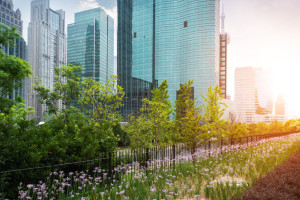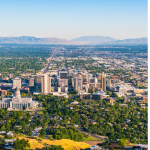 One of the core principles of engineering is sustainability. In the past few decades of our experience as a civil engineering firm, sustainability has become even more critical to our work. As climate change issues worsen, sustainable design practices are becoming a necessity. One tool that is helping to encourage more sustainable and environmentally conscious design is a Leadership in Energy and Environmental Design (LEED) certification.
One of the core principles of engineering is sustainability. In the past few decades of our experience as a civil engineering firm, sustainability has become even more critical to our work. As climate change issues worsen, sustainable design practices are becoming a necessity. One tool that is helping to encourage more sustainable and environmentally conscious design is a Leadership in Energy and Environmental Design (LEED) certification.
What is LEED Certification?
The US Green Building Council (USGBC) created the LEED certification, and it is now a globally recognized program that signifies a building or development meets specific standards for sustainable design. There are several categories for construction, operation, design, operation and maintenance. LEED certification is awarded on points corresponding to different certification levels: platinum is the highest, followed by gold, silver, and certified.
How is a project LEED certified?
Completing the LEED certification process is challenging. Documentation showing compliance with LEED requirements must be submitted to the USGBC to qualify. Then, the project is evaluated based on the documentation and an evaluation, and the USGBC awards points in the different categories to reach the certification levels. The categories assessed for certification include carbon, energy, water, waste transportation, materials, health and indoor air quality. The USGBC has developed the LEED certification program into a globally recognized leader in encouraging and supporting sustainable design and annually invests more than $30 million to operate the LEED certification process.
What are the benefits of LEED certification?
Earning a LEED certification for a project is much more than just an accolade to put on a project. It’s a prestigious certification that helps the environment. Projects that earn LEED certifications at any level come with great benefits, including:
- Reduced energy consumption: LEED buildings/projects encourage sustainable, energy-conscious designs to reduce energy waste and greenhouse emissions. As a bonus for owners, these projects usually have lower utility costs over their lifetime.
- Healthier indoor environments: Improved air quality and ventilation are a by-product of LEED certification. For tenants in a LEED-certified building or project, this can significantly improve their overall health, which may help reduce their healthcare expenses and needs. For businesses that operate in a LEED-certified building, this means their employees may be healthier, and they may see more health benefit savings.
- Market advantages: The LEED certification program is widely respected and regarded worldwide. As more investors, tenants, and customers look for environmentally conscious options, LEED certification may help your building/project attain a competitive edge.
- Financial and tax incentives: Governments are beginning to recognize the importance of sustainable construction and are supporting the LEED program. Federal, state, and local governments in the US offer tax deductions, credits, and accelerated depreciation options to encourage LEED certification and sustainable construction. For example, section 179D of the Energy Policy Act allows for tax deductions of $1.80 per square foot for buildings that achieve significant energy savings.
How does landscape architecture contribute to LEED certification?
Landscape architecture plays a critical role in earning LEED credits towards a project’s certification. A project’s landscape design can significantly affect the choice of materials used, how much water is used, overall energy efficiency, and human health. Here are a few examples of how sustainable landscape architecture practices can help a project achieve LEED certification.
- Water Management: Responsible and sustainable water management is essential for LEED certification. Some water management practices that encourage sustainable water management may include drought-tolerant design, rainwater harvesting or utilizing grey water, permeable pavements, and much more.
- Energy efficiency: Although landscape designs typically use little energy, they can still factor into a building or project’s energy usage. One way that landscape design can help lower overall energy costs is by incorporating practices that reduce the urban heat island around a building or area. Some examples of this include shading structures, mature trees with large canopies, or even green roofs.
- Eco-conscious material selection: One category of LEED certification is the sustainability of the materials used in the construction process, and this includes landscape materials. Landscape materials that are low impact, recycled, locally sourced, and sustainable can help improve your building or project’s LEED certification rating.
Project Spotlight – IHC Riverton Hospital, Utah
We’ve worked on several landscape architecture projects that have pursued a level of LEED certification. One of those projects, the IHC Riverton Hospital in 2014, was especially rewarding. This project has earned silver-level certification and includes landscape architectural consulting services for the 4-story outpatient building expansion, including parking lots, outdoor landscaping, and an outdoor physical therapy courtyard. Not only was this program rewarding because we got to implement principles of sustainable design and earn a Silver LEED rating, but it was also a project that helped encourage healing and community.
Let us help your project earn a LEED rating
So, if you’re considering pursuing a LEED rating for your next development, we can help. With our experience in sustainable landscape architecture, we can help your project meet the rating requirements and reap the environmental, health, and financial benefits of a LEED rating. http://mcneilengineering.com








